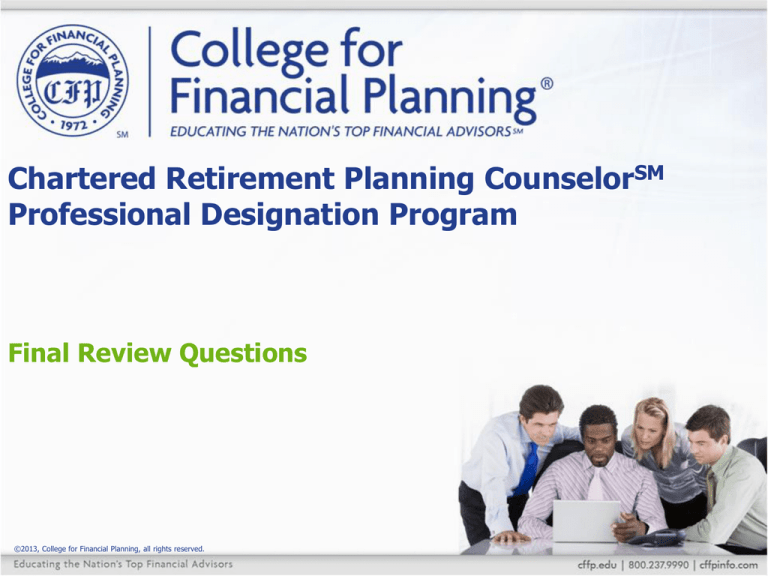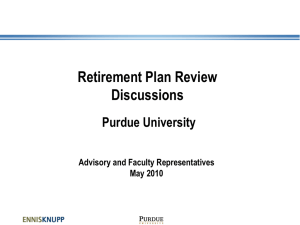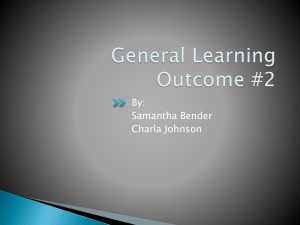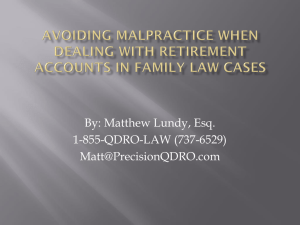
Chartered Retirement Planning CounselorSM
Professional Designation Program
Final Review Questions
©2013, College for Financial Planning, all rights reserved.
Question 1
Andy and Lori Cookston had a combined gross
salary of $85,000 in 201X. Other cash inflows
amounted to $9,800. Their fixed cash outflows
were $26,300, and their variable cash outflows
were $64,700. What was the Cookstons' net
cash flow for 201X?
a. $6,000 deficit
b. $3,800
c. $30,100
d. $68,500
Review - 2
Question 2
Mary wants to have a retirement income of
$60,000 protected against 3% inflation. She
assumes that she will earn 9%, and wants to
have the income for 30 years. How much
capital will be required to provide Mary this
much income at the first of each year? (Set
your calculator for four decimal places.)
a. $616,419
b. $671,897
c. $841,589
d. $890,589
Review - 3
Question 3
Sally needs an annual retirement income of
$48,000 protected against 2% inflation. You are
to assume that she will earn 8%, and wants to
have the income for 25 years. How much
capital will be required to provide Sally this
much income at the first of each year?
a. $512,389
b. $553,380
c. $620,521
d. $657,022
Review - 4
Question 4
The 10% early withdrawal penalty applies to all of the
following distributions except when
a. the participant, age 45, receives a distribution of $5,000
per year for five years after terminating employment.
b. the participant, age 56, withdraws $155,000 from his
IRA after separating from service.
c. the participant, age 50, receives a $50,000 distribution
from the company profit-sharing plan after terminating
employment. Forty-five days later, she is totally disabled.
d. the participant, age 45, withdraws $508 per month for
10 months after terminating employment to pay for
medical insurance. She received unemployment
compensation for 14 weeks following her termination.
Review - 5
Question 5
Which one of the following types of qualified
plans is not subject to the 25% maximum
employer contribution limit?
a. LESOP
b. stock bonus ESOP
c. profit sharing ESOP
d. simplified employee pension plan (SEP)
Review - 6
Question 6
Which one of the following is not a
characteristic of a simplified employee pension
(SEP)?
a. mandatory annual contributions
b. statutory eligibility requirements
c. lack of vesting schedules
d. may be established as late as the due date
of the employer’s tax return
Review - 7
Question 7
Which one of the following is not a correct
statement about a SIMPLE 401(k) plan?
a. The employer does not have the option of
providing a 2% nonelective contribution.
b. To offer a SIMPLE 401(k) plan, the employer
cannot have more than 100 employees who
earn $5,000 or more.
c. To offer a SIMPLE 401(k) plan, the employer
cannot sponsor another qualified plan.
d. An employee may elect to contribute up to
$17,000 of her salary per year.
Review - 8
Question 8
Roger works for the state and participates in the
Section 457 plan offered by the state. Roger’s
annual salary from the state is $60,000. Roger also
qualifies for a SIMPLE IRA with a firm where he
works part time. In 2013, Roger deferred $5,000 of
his part-time earnings to the SIMPLE IRA.
What is the maximum amount Roger can contribute
to the Section 457 plan for 2013?
a. $5,500
b. $12,500
c. $17,500
d. $35,000
Review - 9
Question 9
To qualify for lump-sum tax treatment, a
distribution must meet all the following
requirements except
a. it must be made in one taxable year.
b. it must be payable due to the participant’s
death or reaching age 59½.
c. it must be made from a qualified plan.
d. it must represent at least 50% of the
participant’s balance
from all qualified plans of a single type.
Review - 10
Question 10
Distributions from qualified plans, 403(b) plans, SEPs,
SIMPLEs, and IRAs are assessed a 10% penalty if they
are taken before age 59½. Which of the following is not
an exception to this penalty?
a. The distribution is made to pay homeowner’s
association dues.
b. The plan participant dies prior to age 59½ and the
distribution goes to the participant’s beneficiary.
c. The distribution is attributed to a permanent
disability.
d. Distributions are made of a series of substantially
equal periodic payments of the plan participant’s life
expectancy.
Review - 11
Question 11
Participant loans are permitted from
a. qualified retirement plans and IRAs.
b. IRAs and 403(b)s.
c. qualified plans and 403(b)s.
d. SEPs and qualified plans.
Review - 12
Question 12
Defined contribution plans that are subject to minimum funding
standards are required to provide a qualified joint survivor annuity
(QJSA). Profit sharing plans are not required to provide a QJSA if
which of the following conditions are met?
I. The plan does not allow for any life annuity options.
II. The plan does not accept direct transfers from other plans that
are subject to
QJSA.
III. The plan provides that the participant’s vested benefits are
payable in full to the participant’s spouse in case the
participant dies prior to retirement.
a. I only
b. I and II only
c. II and III only
d. I, II, and III
Review - 13
Question 13
Which of the following events would result in income
taxation to a plan participant?
a. The participant rolls over his or her assets into a
conduit IRA, then rolls over the assets into another
qualified plan.
b. The participant takes a distribution from a qualified
plan and rolls it over into an IRA 75 days later.
c. The participant uses a direct transfer to move his
plan assets from one qualified plan to another.
d. The participant accepts a check made out to the
trustee of an IRA and delivers it to the trustee one
day later.
Review - 14
Question 14
All the following are health plan options under
Medicare Advantage plans except
a. Medicaid Provider Plans (MPPs).
b. Health Maintenance Organizations (HMOs).
c. Preferred Provider Organizations (PPOs).
d. Private fee-for-service plans.
Review - 15
Question 15
Which of the following is not a requirement to
be eligible for Social Security disability benefits?
a. An individual must be younger than the
Social Security normal retirement age.
b. The disability must be terminal or expected
to last at least 12 months.
c. After age 31, the worker must have worked
in Social Security employment for at least
five of the last ten years.
d. The individual must have had average
annual earnings of at least $15,000 during
five of the last ten years.
Review - 16
Question 16
Which one of the following is not considered to
be a qualified medical expense for purposes of
the Health Savings Account rules?
a. premium payments for Medicare Part A
b. premium payments for Medicare Part B
c. premium payments for long-term care
insurance
d. premium payments for a Medigap policy
Review - 17
Question 17
Which of the following is not an example of a
gift subject to the federal gift tax?
a. forgiving a legal debt of $19,000 owed by a
friend
b. exchanging property worth $25,000 for
property worth $11,000
c. paying a friend’s legal fees of $15,000
d. paying a niece’s hospital bill of $25,000
Review - 18
Question 18
Robert made a gift to John of property worth
$50 for which he had paid $75 two years ago.
One year after the gift, John sold the property
for $45. Which one of the following amounts
represents John’s basis in the property to
compute his gain or loss?
a. $45
b. $50
c. $75
d. The basis cannot be determined based on
the information provided.
Review - 19
Question 19
Stock A has an expected return of 15% and a
standard deviation of 7.5%. Stock B has an
expected return of 18% and a standard
deviation of 9%. Based on the coefficient of
variation, which stock has more relative risk?
a. Stock A.
b. Stock B.
c. Both have the same relative risk.
d. The two stocks cannot be compared.
Review - 20
Question 20
The correlation of asset class returns is
a. useful since it increases their aggregated
return.
b. important since it increases as interest rates
decline.
c. a measure of how the asset classes’ returns
move relative to one another.
d. caution flag since it is an indication of
excessive risk.
Review - 21
Question 21
Henry and his wife Etta will both reach their NRAs this
month, and they both plan to begin receiving Social
Security benefits next month. Etta’s primary insurance
amount (PIA) is $1,900; Henry’s PIA is $975. What will
their Social Security benefit be?
a. Etta will receive $1,900, and Henry will receive 50%
of Etta’s PIA.
b. They will both receive their respective PIAs.
c. Henry will receive his PIA plus 50% of Etta’s PIA;
Etta will receive her PIA plus 50% of Henry’s PIA.
d. Their total benefits cannot exceed $2,500, the
maximum allowed by law for a married couple.
Review - 22
Question 22
Susan Edwards is the president of research and
development for Bionic Pharmaceutical, and she earns
an annual salary of $600,000. Susan will be entitled to
an annual retirement benefit equal to $130,000 under
the formula of the company’s qualified defined benefit
plan.
Which one of the following nonqualified deferred
compensation plans should be used to make Susan
whole for the loss of benefits caused by the qualified
plan compensation limit?
a. excess benefit plan
b. top hat plan
c. pure deferred compensation plan
d. secular trust
Review - 23
Question 23
Which one of the following retirement plans is
exempt from the requirements of ERISA?
a. funded excess benefit plan
b. funded supplemental executive retirement
plan
c. unfunded excess benefit plan
d. unfunded supplemental executive retirement
plan
Review - 24
Question 24
Regarding defined contribution plans, it is not
true that
a. there are no “reduced benefit” provisions.
b. they promise to pay a particular benefit at
retirement.
c. they provide a separate account for each
participant.
d. participants are offered their vested benefit
in a lump sum at retirement.
Review - 25
Question 25
Early retirement programs typically may not
offer
a. enhancement of pension benefits in excess
of ERISA regulations.
b. severance benefits.
c. health and insurance benefits.
d. pre-retirement and tax counseling.
Review - 26
Question 26
“Golden parachute” agreements may include
which of the following?
I. cash
II. company stock
III. medical and life insurance
IV. extra pension benefits
a. I only
b. I and IV only
c. II and III only
d. I, II, III, and IV
Review - 27
Question 27
The asset allocation approach that seeks to
provide optimal balance between expected risk
and expected return for a long-term investment
horizon is called
a. tactical allocation.
b. value/growth allocation.
c. optimal risk/return allocation.
d. strategic allocation.
Review - 28
Question 28
Which one of the following types of qualified
plans is considered to be a defined benefit
plan?
a. profit sharing plan
b. target benefit plan
c. cash balance plan
d. money purchase pension plan
Review - 29
Question 29
Which one of the following is a possible
disadvantage of a nonqualified deferred
compensation plan?
a. It gives the employer little flexibility in
targeting plan benefits.
b. It can only be designed as a salary reduction
agreement.
c. Income tax rates may actually be higher by
the time an executive retires.
d. The Section 409A provision that requires the
removal of any forfeiture provision in the
plan.
Review - 30
Question 30
What will be the amount and character of the loss
carryover to the subsequent year, if any, if Sally has the
following capital transactions during the year?
I. Long-term capital loss on sale of ABC stock
$(6,500)
II. Long-term capital gain on sale of DEF stock $ 2,200
III. Short-term capital gain on sale of XYZ stock $ 1,000
a. $0
b. $300 short-term capital loss carryover
c. $300 long-term capital loss carryover
d. $1,300 long-term capital loss carryover
e. $1,300 short-term capital loss carryover
Review - 31
Chartered Retirement Planning CounselorSM
Professional Designation Program
Final Review Questions
End of Slides
©2013, College for Financial Planning, all rights reserved.









